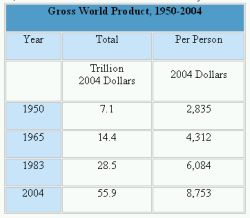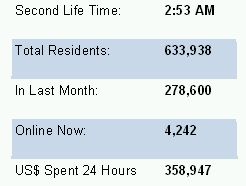Insight: While discussing terrorism and immigration, it occurred to me that economics may be the basic cause...not, I'm sure, a very original thought. A quick Google search found Gross World Product, 1950-2004 where the doubling time for the GWP was seen to be 15 years after 1950, 18 years after 1965, and 20+ years after 1983...not a very healthy trend! Of course the per capita GWP was substantially worse, doubling in 40+ years. So, on the average, people could look forward to a life time before their wealth doubled.
to me that economics may be the basic cause...not, I'm sure, a very original thought. A quick Google search found Gross World Product, 1950-2004 where the doubling time for the GWP was seen to be 15 years after 1950, 18 years after 1965, and 20+ years after 1983...not a very healthy trend! Of course the per capita GWP was substantially worse, doubling in 40+ years. So, on the average, people could look forward to a life time before their wealth doubled.
Think what the world may be like if the doubling time were 10 years, or the 1-2 year doubling time of technology? If rising tides were shared, would we all not have too much to lose for terrorism or emigration to be so central to our lives? How could we bootstrap a dramatically shorter DWP doubling time? The rising educated and middle class in China and India certainly will double world production, probably even within this ten year period. But how can this new wealth penetrate to where the problems are? What if we were to try a system of transfer payments? Let's put money into the dens of terrorists and spawning ground for emigrants; let’s pay them so they can buy goods and services. So they too can become invested in the system and have too much to lose.
Is such an insight beyond belief or simple economics? Economics is devoted to optimum allocation of scarce resources. But what if resources were not scarce? Accelerating technology (a common theme we’ll come back to time and time again) leads to such a short doubling time and to many of the goods and services we will associate with wealth. Digital "products" can be infinitely copied so there can only be artificially created scarcities. So, if much of our wealth were based on technology and digital goods, we all can be wealthy! We'll return to this theme.
Insight: While we’re on the subject of digital products, let’s jump all the way--into digital worlds and the environment. Many of our environmental concerns  have their roots in our living in the “real world “. We move around massive amounts of atoms to do even the simplest things and this costs in energy and physical resources and produces pollution (entropy). Many people are exploring a better way--moving many facets of their lives into digital or virtual worlds. Most of these worlds are themed online games where players found other players and much of their play became centered on living-type activities. A few worlds were open to modification and evolution by “players” and become rich places to live and work. One such world is Second Life (mentioned previously) where life goes on day by day for hundreds of thousands of people worldwide and for hundreds of thousands of US dollars worth of transactions. This will be a main and continuing theme.
have their roots in our living in the “real world “. We move around massive amounts of atoms to do even the simplest things and this costs in energy and physical resources and produces pollution (entropy). Many people are exploring a better way--moving many facets of their lives into digital or virtual worlds. Most of these worlds are themed online games where players found other players and much of their play became centered on living-type activities. A few worlds were open to modification and evolution by “players” and become rich places to live and work. One such world is Second Life (mentioned previously) where life goes on day by day for hundreds of thousands of people worldwide and for hundreds of thousands of US dollars worth of transactions. This will be a main and continuing theme.
Insight: Many smaller, cheaper displays may make a great inexpensive display wall or surround.
Display walls have multiple LCD panels closely abbuting to form multiple images on any subset of panels or one large display, as shown from Septre . Multiple displays are also used to construct surrounds like shown by DigitalTigers or 9XMedia .
Now if these were built from standard LCDs such as an "Acer AL1906AB / 19" / 8ms / 500:1 / SXGA 1280 x 1024 / Black / LCD Monitor ... incorporating the latest LCD technology...$159.99" they would cost under $1000 instead of over two to three times as much. The specific Acer LCD seems to have ½“ bezel so if the bezel can be removed the inter-LCD gap could be about ¼”. If 17” 1280x1024 LCDs were used, the resolution would be about 100ppi at a cost that should be about $100 per panel. Windows XP Professonal already supports up to 10 display controllers and many display controllers can handle four displays. So it would seem possible to construct a wall 40 displays for about $4,000 and control it with 10 controller boards at perhaps $3-500 each. On a smaller scale, a 6 display surround could be under $2,000.

No comments:
Post a Comment